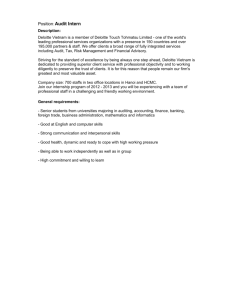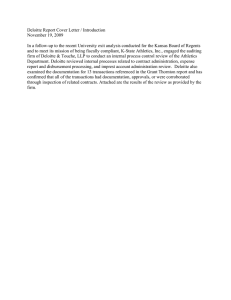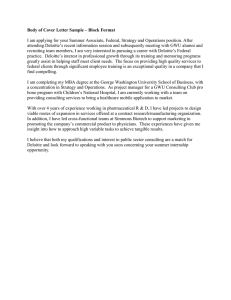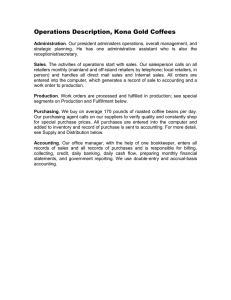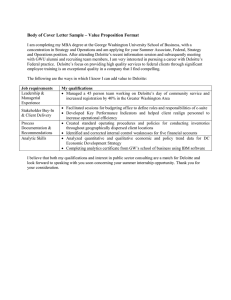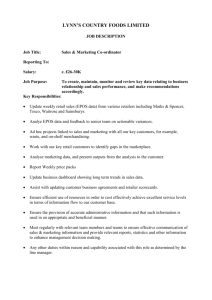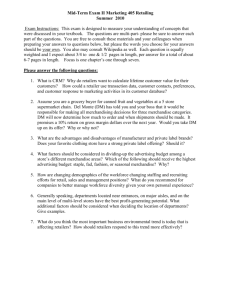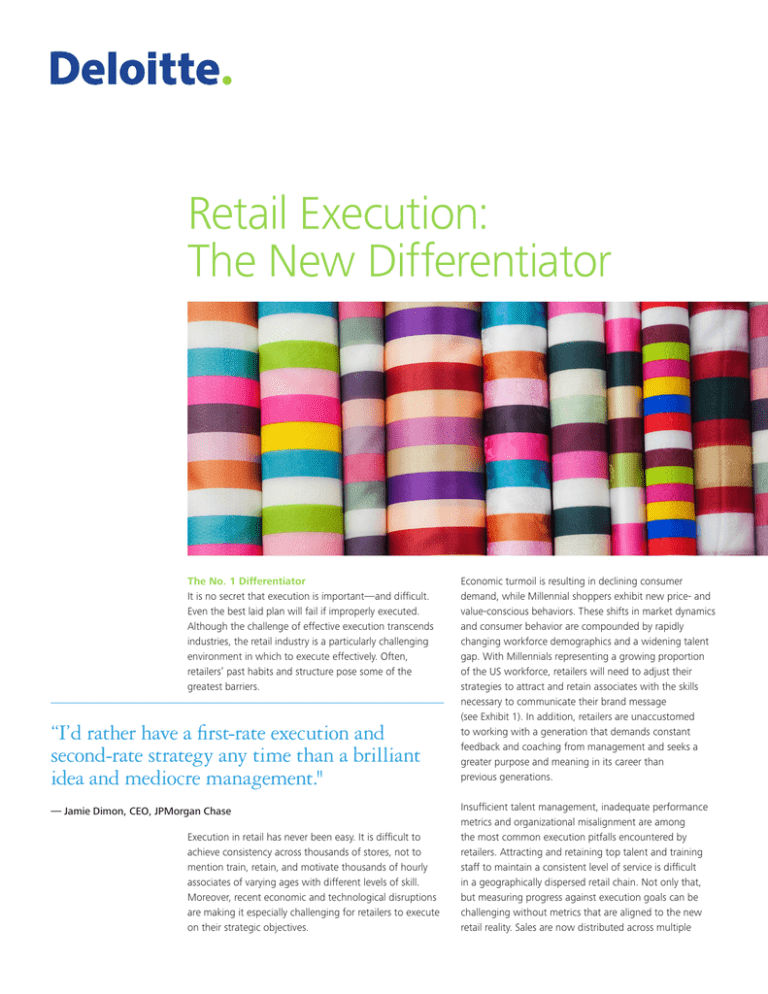
Retail Execution:
The New Differentiator
The No. 1 Differentiator
It is no secret that execution is important—and difficult.
Even the best laid plan will fail if improperly executed.
Although the challenge of effective execution transcends
industries, the retail industry is a particularly challenging
environment in which to execute effectively. Often,
retailers’ past habits and structure pose some of the
greatest barriers.
“I’d rather have a first-rate execution and
second-rate strategy any time than a brilliant
idea and mediocre management."
— Jamie Dimon, CEO, JPMorgan Chase
Execution in retail has never been easy. It is difficult to
achieve consistency across thousands of stores, not to
mention train, retain, and motivate thousands of hourly
associates of varying ages with different levels of skill.
Moreover, recent economic and technological disruptions
are making it especially challenging for retailers to execute
on their strategic objectives.
Economic turmoil is resulting in declining consumer
demand, while Millennial shoppers exhibit new price- and
value-conscious behaviors. These shifts in market dynamics
and consumer behavior are compounded by rapidly
changing workforce demographics and a widening talent
gap. With Millennials representing a growing proportion
of the US workforce, retailers will need to adjust their
strategies to attract and retain associates with the skills
necessary to communicate their brand message
(see Exhibit 1). In addition, retailers are unaccustomed
to working with a generation that demands constant
feedback and coaching from management and seeks a
greater purpose and meaning in its career than
previous generations.
Insufficient talent management, inadequate performance
metrics and organizational misalignment are among
the most common execution pitfalls encountered by
retailers. Attracting and retaining top talent and training
staff to maintain a consistent level of service is difficult
in a geographically dispersed retail chain. Not only that,
but measuring progress against execution goals can be
challenging without metrics that are aligned to the new
retail reality. Sales are now distributed across multiple
interdependent channels, and measuring the relative
success of each channel is difficult. Once retailers can
adjust and make changes to its organizational structure or
customer-facing strategies, it is often too late as the world
has already changed.
All of this is happening as digital commerce and the
“Internet of Things” are increasing consumer expectations
and changing how they shop. Given this environment,
it is not surprising that many retail strategies remain just
that—strategies, which often fail to produce their intended
results. Ninety percent of organizations fail to effectively
execute their strategies and realize the full benefits of their
efforts¹ and, in an increasingly complex retail environment
with intense competition and limited resources, execution
has become the No.1 differentiator.
Exhibit 1: Millennials are changing the workforce²
36%
75%
Of the workforce are
Millennials today
Of the workforce will be Millennials by 2030
Keys to Execution Success
Successful execution of strategies and programs is
an iterative and rigorous process. Identifying the
necessary skills and recruiting the right talent, training
and developing associates, measuring and evaluating
the efficacy of programs and intervening and adjusting
when needed are all critical steps for a successful
implementation. Retailers should consider a four-step
iterative execution process—not just for some, but for all
implementations—and they must apply rigor in every step
of the way (see Exhibit 2). Clear and open communication
to support and empower associates at every stage of the
process is paramount to its success.
Exhibit 2: Iterative execution process
Step 1: Identify Talent Needs and Recruit The first step a retailer should undertake before they
execute on a strategy is to inventory the skills of their
current associates and determine if they match the
skills required for effective execution on that strategy.
This search for talent, both internal and external to the
organization, is critical. Retailers must recognize that the
new reality will require developing new skills and getting
the right people in the right roles. In an omnichannel
world, retailers need a workforce that can deliver a
customer experience that is more than transactional.
They will want associates that are adept at crafting and
navigating the digital innovations that are necessary to
compete. As a result, retailers are now competing for top
talent with tech companies in Silicon Valley as much as
traditional industry competitors, and they must identify
new approaches to attracting and maintaining talent.
For prospective talent, the differentiator in choosing where
to work often depends on a company’s culture, work
environment, community impact, and opportunities for
advancement and professional development. In recruiting
a new and demographically different workforce, managers
must create opportunities that tap into Millennials’ need
for purpose and positive impact and be able to effectively
communicate to multiple generations (see Exhibit 3).
Exhibit 3: Millennials exhibit new behaviors from
their predecessors³
89%
want their workplace
to be social and fun
88%
consider “positive
culture” important to
their dream job
69%
45%
believe regular
office attendance is
unnecessary
will choose workplace
flexibility over pay
Communication
2
Step 2: Train and Develop
After talent is identified, retailers must develop a culture
of learning and define training programs that cater to
this new generation of associates. Millennials want to
do impactful work and be challenged; they seek out
continuous feedback and coaching from their managers
and have limited appreciation for administrative processes
(i.e., annual performance reviews). This requires managers
to increase communication with store associates, through
both formal and informal channels.
Since customers can now buy products anywhere, the
store’s point of differentiation is an excellent customer
experience and a knowledgeable sales associate. In
fact, knowledgeable sales associates are by far the most
important factor that can help increase the likelihood of an
in-store purchase⁴. However, as the store’s role evolves to
that of a hub for customers to experience the brand, store
associates are responsible for creating more than a salesdriven transactional experience, and need to be trained
and incentivized to be brand ambassadors. Retailers have
an opportunity to develop targeted mentoring and training
programs to improve their associates’ soft skills, and to
motivate them and give purpose by leveraging corporate
social responsibility initiatives and providing them with
greater autonomy and responsibility.
Step 3: Measure and Evaluate
Once retailers have identified talent and trained project
staff, the next step in the execution process requires
applying science to the implementation. Now more than
ever, retailers must systematically measure the outcomes
of every initiative and determine its efficacy. Metrics and
key performance indicators (KPIs) must be adapted to
reflect retailing in the digital age, with a focus on customer
experience and quality. For example, sales per square
foot and same store sales metrics make less sense in an
omnichannel retail environment, where store footprints
are shrinking and the store is now an environment for
customers to experience the brand, rather than just a
channel to transact. Often customer touch points in the
store drive sales online and vice versa, and metrics need to
take into account this digital influence.
CASE STUDY: ITERATIVE
EXECUTION PROCESS IN ACTION
Implementing a Clienteling Tool at a Fashion
Retailer: In today’s omnichannel retail
environment, many retailers are turning to
clienteling as a way to provide a unique and
valuable in-store shopping experience.*
Step 1: Identify pilot stores where the clienteling
tool will be tested. Communicate with the field
to prepare pilot stores for the upcoming changes.
Assess staffing needs and recruit as necessary.
Step 2: Train pilot store associates on how to
use the new tool. Plan for on-the-job coaching
to ensure the skill gap is closed and to drive
adoption. Build the case for the new tool and
establish an associate feedback process.
Step 3: Measure carefully selected KPIs in the
pilot stores (e.g., sales lift across channels,
in-store traffic) and evaluate them against a
control group. Communicate the successes to the
rest of the organization.
Step 4: If necessary, intervene and make
adjustments to the clienteling tool and training
and coaching approach; create a rollout plan
for the entire chain consisting of multiple waves
and prepare the field for the upcoming changes
through frequent communications.
Steps 5–7: Recruit and train Wave 1 store
associates on how to use the new tool. Measure
adjusted KPIs from the pilot. If necessary,
intervene and make adjustments to the clienteling
tool and training and coaching approach.
Steps 8+: Repeat with Wave 2, etc.
*Fictitious example for illustrative purposes
A first step in identifying the right KPIs and metrics is to
pilot the initiative in a subset of stores or geographies.
In this way, a retailer can adjust before expanding the
initiative to the full organization. Once the proper KPIs
are developed, manager and store associate incentives
must be aligned and effective internal communication
channels established. Clear communication and
transparency are critical in aligning thousands of store
associates around new metrics and rewarding the right
behaviors consistently.
3
Step 4: Intervene and Adjust
Finally, to execute efficiently, retailers must be willing and
able to adapt based on internal and external forces and
quickly adjust their implementation plans. They must not
only be able to collect and interpret large data sets to
determine the merit of new innovations and campaigns,
but also be able to pivot quickly based on this new
information, adjust and communicate the necessary
changes to the workforce. Too often retailers recognize
that changes need to be made, but by the time they
align the organization, the world has changed and they
must adjust again. Clear lines of communication and
transparency of organizational goals are key to accomplish
the quick adjustments necessary for efficient execution. It
is critical that any updates are communicated effectively
from the top of the organization down through its ranks
to gain ownership and support throughout the business,
especially in an environment where store managers are
often preoccupied with day-to-day operations
and firefighting.
Summary
The recipe for retail success is evolving. Surviving and
coming out on top in an increasingly competitive industry
will require not only a differentiated strategy, but also
execution and performance. Successful execution is an
iterative and rigorous process supported by clear and
open communication. Retailers must continuously identify
talent needs and recruit accordingly, train and develop
their people, measure and evaluate the results of their
initiatives and course correct when needed. By being aware
of the changes mandated by the new retail landscape
and addressing common pitfalls, retailers can position
themselves for execution success.
¹ Deloitte research
² U.S. Bureau of Labor Statistics
³ Peoplefluent.com, badgeville.com
⁴ Deloitte’s 2014 Annual Holiday Survey
Authors
Lisa Gomez
Principal
Deloitte Consulting LLP
+1 703 251 3583
lisgomez@deloitte.com
Rod Sides
U.S. Consulting Leader, Retail & Distribution
Principal
Deloitte Consulting LLP
+1 704 887 1505
rsides@deloitte.com
Deloitte acknowledges the following contributors: Elitza Barzakova, Tanya Pramatarova, and Brendan Ward.
For further information, visit our website at www.deloitte.com/us/retail-distribution
As used in this document, "Deloitte" means Deloitte Consulting LLP, a subsidiary of Deloitte LLP. Please see www.deloitte.com/us/about for a
detailed description of the legal structure of Deloitte LLP and its subsidiaries. Certain services may not be available to attest clients under the rules
and regulations of public accounting.
This publication contains general information only and Deloitte is not, by means of this publication, rendering accounting, business, financial,
investment, legal, tax or other professional advice or services. This publication is not a substitute for such professional advice or services, nor should
it be used as a basis for any decision or action that may affect your business. Before making any decision or taking any action that may affect your
business, you should consult a qualified professional advisor. Deloitte shall not be responsible for any loss sustained by any person who relies on
this publication.
Copyright © 2015 Deloitte Development LLC. All rights reserved.
Member of Deloitte Touche Tohmatsu Limited.

